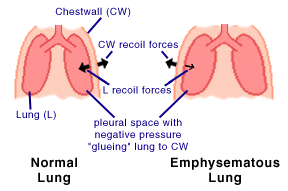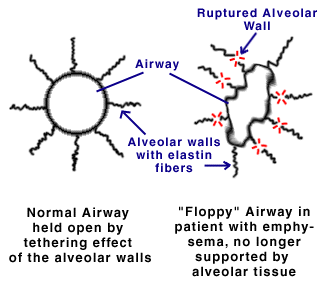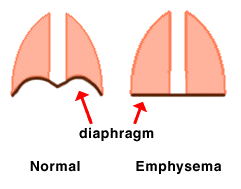Course Authors
E. Neil Schachter, M.D.
Dr. Schachter reports no commercial conflict of interest
Estimated course time: 1 hour(s).

Albert Einstein College of Medicine – Montefiore Medical Center designates this enduring material activity for a maximum of 1.0 AMA PRA Category 1 Credit(s)™. Physicians should claim only the credit commensurate with the extent of their participation in the activity.
In support of improving patient care, this activity has been planned and implemented by Albert Einstein College of Medicine-Montefiore Medical Center and InterMDnet. Albert Einstein College of Medicine – Montefiore Medical Center is jointly accredited by the Accreditation Council for Continuing Medical Education (ACCME), the Accreditation Council for Pharmacy Education (ACPE), and the American Nurses Credentialing Center (ANCC), to provide continuing education for the healthcare team.
Upon completion of this Cyberounds®, you should be able to:
Emphysema is defined histologically as a widespread loss of alveolar structures (primarily alveolar epithelium and endothelium). The majority of patients afflicted with this disease are smokers or former smokers. The basis of the disease is unknown, but it is felt to be the consequence of inflammation and associated proteolysis are insufficiently restrained by the lung's anti-elastase system (see Cyberounds®: Programmed Emphysema). Medical intervention in this disease has generally been found to yield only modest effects on symptoms and mortality. As a consequence, the public's and physicians' perception of this disease is that it is irreversible and leads inevitably to respiratory disability and death. It is therefore not surprising that any intervention like lung reduction surgery, the topic here, that promises a prompt and measurable reversal of the natural course of this illness arouses great interest and hope.
Currently, the National Heart, Lung and Blood Institute and the Health Care Financing Administration are conducting a multi-center clinical trial at 18 selected institutions across the country to determine the safety and effectiveness of a surgical therapy for this illness. Approximately 2600 patients will be entered into this trial. Patients will be followed for at least 36 months.
Background
Surgical management of emphysema dates to 1906 when Freund(1) suggested (erroneously) that the "barrel chest" seen with emphysema was the cause (rather than the result) of emphysema. Based on this interpretation it was suggested that ostochondrectomy and transverse sternotomy might be used to treat this disease of "stiff thorax dilation." When the relationship between reduced lung recoil and chest overexpansion was better defined (see below) a series of thoracic interventions was proposed. The first was an intervention made popular in the era of TB surgery. Thoracoplasty and phrenic nerve crush were introduced to reduce lung inflation and thereby "reverse" poor ventilation; the result of this procedure, however, was to increase respiratory impairment. A more rational approach sought to "reconfigure the diaphragm" in order to return it to a position from which it could effectively function either by external devices (e.g., pneumobelt) or by introducing air into the peritoneal cavity. The former continues to be used on occasion by Respiratory Care services. The latter, although associated with transient improvement in lung function, proved impractical because air was rapidly absorbed from the peritoneal cavity.
Another surgical approach, ultimately doomed by its faulty physiology, was based on the observed hypo-vascularity of the emphysematous lung. Attempts at stimulating collateral circulation from the chest wall involved introducing irritants (such as talc) into the pleural space. This, of course, had no influence on the pulmonary arterial capillary bed which was destroyed along with the alveolar walls during the course of emphysema.
In the 1950's Brantigan and his co-workers introduced a procedure which involved multiple wedge resections of the peripheral lung "to prevent expiratory collapse of small airways." The rationale for this operation was that resection of the most extensively damaged peripherally affected lung would increase overall lung elastic recoil and increase the retractive forces on airways and blood vessels. While the physiologic basis for this surgery appeared reasonable, Brantigan himself failed to document physiologic improvements in patients undergoing this operation and in particular these interventions were associated with a high morbidity (e.g., prolonged air leaks from resected tissue) and a high post operative mortality (27%).
In spite of the poor surgical outcome with Brantigan's technique, Rogers and his co-workers established that the underlying physiology was sound by showing that the surgery was associated with iprovement in airway conductance, lung volumes and conductance to lung volume ratios, as had been predicted by the model(2) However, these authors sounded a cautionary note: within 12 to 18 months, lung function returned to pre- operative values. Based on these disappointing results, lung reduction surgery was abandoned for the next three decades, only to witness a dramatic rebirth in the mid 1990's accompanied by a rapid counter-reaction again questioning the physiologic basis of the surgery and its actual results.
The revival of this surgery resulted from several merging currents in the surgical treatment of lung disease and in the availability of new technology. Hope that surgical intervention could play a role in emphysema was associated with the success of lung transplantation. After a delayed entry into the transplant field, technical innovations in the 1980's elevated lung transplantation to a level of feasibility comparable to that of transplanting other organs. Despite lung transplantations's impressive successes, it has proved to be of limited practicality. Donors are hard to come by; there are post-transplant complications; and there are relatively strict rules for recipient selection.
In contrast, "reduction surgery" appears to be, for the selected emphysematous patient a more appealing alternative. Unlike transplantation, it does not require immunosuppression and does not carry the risk of rejection. Improved technology, in particular lung scanning, the universal availability of sophisticated pulmonary function testing and lung imaging improves, at least theoretically, our ability to evaluate these patients preoperatively. Finally, progress in thoracic surgical technique, particularly bilateral lung resection (in earlier operations, unilateral resections almost all had rapid loss of lung function improvement following surgery) and use of bovine pericardial strips to buttress the staple line(3) has enhanced the success of this surgery permitting greater and more balanced reduction and elimination of most of the prolonged air leaks occurring post operatively. Early reports suggest that 90% of patients undergoing this operation can be extubated in the immediate post-operative period.
Physiologic Basis For Functional Improvement in Lung Reduction Surgery
It is not known as yet whether improvement seen following reduction surgery is permanent or transient. The physiologic basis for improvement is also uncertain, but three potential mechanisms are frequently cited: increased elastic recoil and improved airflow, improvement of respiratory muscle function, and improved cardiovascular function.
Increased Elastic Recoil and Improved Airflow
One of the major consequences of emphysema is the loss of lung elastic recoil as alveolar m tissue in general, and elastic fibers in particular, are consumed by the disease. This loss of elastic recoil has two obvious consequences.
Hyperinflation of the chest increases as elastic recoil forces of the lung decrease and the recoil forces of the chest wall (which are directed outward) tend to pull the thorax to a new (larger) position of equilibrium (see Figure 1).
Figure 1. Hyperinflation of the Lung As a Result of Loss of Lung Recoil Forces.

Dynamic compression of the airways. With loss of alveolar tissue, airways become "floppy" and collapse easily (see Figure 2) with small changes in intra-thoracic pressure (e.g., normal breathing).
Figure 2. Normal vs. 'Floppy' Airways.

Theoretically, by excising the most "damaged" parts of the emphysematous lungs, the overall recoil forces of the remaining tissue should increase, thereby reducing hyperinflation and diminishing the number of airways subject to dynamic compression.
Improvement of Respiratory Muscle Function
In patients with emphysema diaphragm muscles are flattened -- even everted -- and the muscle fibers are shortened (see Figure 3).
Figure 3. The Flattening of the Diaphragm in Emphysema.

This shortening of the diaphragm muscles means that individual muscle fibers are not at their optimum length-tension configuration and therefore cannot work as efficiently. Additionally, because they are flattened, further shortening does not increase lung volume and therefore the diaphragm's contribution to ventilation is lost.
Improved Cardiovascular Function
The same tethering effect depicted in Figure 2 (although somewhat more complicated) that is useful in keeping airways open, is useful in keeping the pulmonary vasculature from collapsing. This support would be most noticeable in the pulmonary capillaries, which are already reduced in number by the destructive process of emphysema.
By increasing lung recoil and decreasing hyperinflation, reduction surgery would theoretically work to reduce pulmonary arterial resistance and improve blood flow. Loss of additional capillaries and pulmonary vessels in the surgery may, however, offset this potential benefit. Interestingly many patients undergoing reduction surgery experience an improvement in Diffusion Capacity (DLCO) suggesting an improvement in the gas exchange capabilities of the pulmonary vasculature.
A recent report by Sciurba(4) involving 20 consecutive patients treated for emphysema with reduction surgery indicates short term physiologic and functional improvement. In particular significant increases in lung elastic recoil as well as reductions in total lung capacity were documented. Functional measurements such as the six minute walk test and patient dyspnea indexes improved. Interestingly, in this group, the DLCO remained unchanged, although measurements of right ventricular function did improve.
In an editorial from the Washington University School of Medicine, Drs. Joel D. Cooper and Stephen Lefrak(5) related that since initiating surgery for emphysema, 120 patients had been treated. Only 1 in 5 patients referred for the surgery were candidates for this procedure by their criteria (primarily severe overinflation and lung destruction). With over a year (average) follow-up physiologic benefits appeared to be maintained. While this editorial called for immediate acceptance of this surgery, caution was urged by the accompanying rebuttal editorial of Drs. Barry Make and Alan Fine.(6) They point out that morbidity and mortality rates for this surgery are unknown, the indications are not standardized and the cost-benefit considerations are not clear. As a result of this debate, Medicare has declared a moratorium on the payment for this procedure pending the outcome of a randomized clinical trial comparing surgical and medical approaches.(7)
At present reduction surgery is a promising technique, but its current availability is restricted to those centers involved in the national protocol. It is hoped that the limitations imposed on today's patients by this cautious approach will be offset by the increased safety and efficacy that the current multicenter study promises.